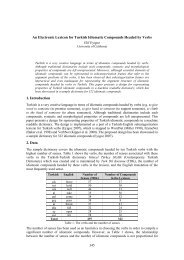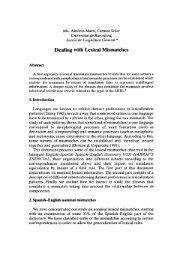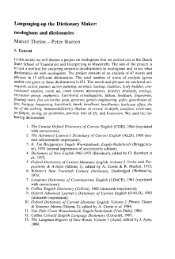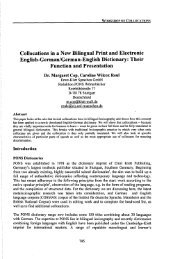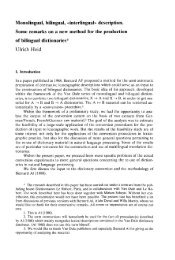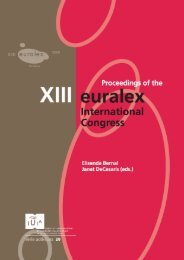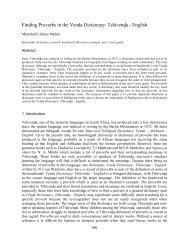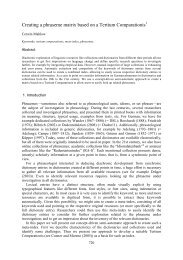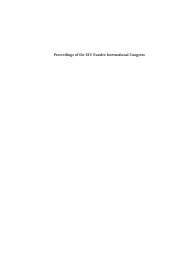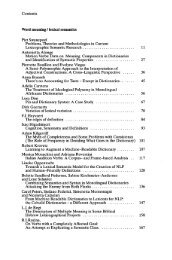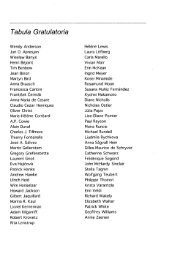Download pdf - Euralex
Download pdf - Euralex
Download pdf - Euralex
Create successful ePaper yourself
Turn your PDF publications into a flip-book with our unique Google optimized e-Paper software.
Using Google Books Unigrams to Improve the Update of Large<br />
Monolingual Reference Dictionaries<br />
Alexander Geyken & Lothar Lemnitzer<br />
Keywords: practical lexicography, computational linguistics, corpus statistics, lemma list.<br />
Abstract<br />
This paper describes ongoing work to extend a traditional dictionary using a large opportunistic corpus in<br />
combination with a unigram list from the Google Books project. This approach was applied to German with the<br />
following resources: the Wörterbuch der Deutschen Gegenwartssprache (WDG, 1961-1977), the German<br />
unigram-list of Google Books and the DWDS-E corpus. Both corpus resources were normalized. The subsequent<br />
analysis shows that the normalized unigram list has clear complementary information to offer with respect to<br />
DWDS-E and that a comparatively small amount of manual work is sufficient to detect a fairly large number of<br />
new and relevant dictionary entry candidates.<br />
1. Introduction<br />
The “Digitales Wörterbuch der Deutschen Sprache” (DWDS, cf. Klein and Geyken 2010) is a<br />
project of the Berlin-Brandenburg Academy of Sciences and Humanities (BBAW). Its goal is<br />
to implement a digital lexical system that combines dictionaries, text corpora and language<br />
statistics (www.dwds.de). At the core of this system is the DWDS dictionary, a monolingual<br />
general language dictionary for German that comprises rich lexicographical information for<br />
approx. 90,000 headwords and minimal (semantic) information for another 30,000<br />
compounds. The DWDS dictionary is based on the digitized version of the six-volume<br />
„Wörterbuch der deutschen Gegenwartssprache“ ([WDG]). The WDG was published between<br />
1961 and 1977 in a traditional way from A-Z, hence the vocabulary after 1975 (depending on<br />
the letter even earlier) is not covered by the dictionary. The project plan of the DWDS project<br />
foresees to update the lexical substance of the DWDS dictionary in the years between 2013<br />
and 2018. The revision process will include the addition of approximately 25,000 new lexical<br />
units as full entries with rich lexicographical information. Furthermore, another 20,000 lexical<br />
entries will be provided with minimal information, basically grammatical information and<br />
corpus citations. The first step of this revision process is the selection of an appropriate<br />
lemma list of 45,000 lexical units. In the remainder of this paper we will briefly describe the<br />
two corpus resources used for the lemma selection process, namely the DWDS-E corpus, an<br />
opportunistic corpus of contemporary German, and the German unigram list of the Google<br />
Books project (section 2). In section 3 and 4 we will present the methods we employed to<br />
make both corpora comparable and thus suitable for a common analysis. We will then present<br />
the results of the extraction process (section 5) and we will draw some conclusions (section<br />
6).<br />
2. Resources<br />
The resources used for the lemma extraction process are two corpora, more precisely, the<br />
annotated word lists extracted from DWDS-E and the Google Books unigram list, henceforth<br />
GB-unigram list. We consider the DWDS-E word type list to be our base list and the other<br />
lists, including the GB-unigram list, to be control lists. From the DWDS-E list we have<br />
gleaned entry candidates for which we can easily get a significant amount of corpus citations.<br />
362
The major purpose of the control lists is to narrow down the search space of the DWDS-E list<br />
to a manageable size and to draw the lexicographer's attention to lexical units which are more<br />
widely used (as made evident by the frequencies in the control lists) than it is reflected in the<br />
DWDS-E corpus list.<br />
DWDS-E is a large opportunistic corpus collection containing texts from 1900 up to<br />
2010. It is continually updated and currently consists of approximately 2.8 billion tokens. For<br />
our study we have extracted all texts from 1980-2009 with a total of 2.5 billion tokens. The<br />
major part of the collection consists of influential daily and weekly national newspapers and<br />
magazines: Bild, Frankfurter Allgemeine Zeitung, Neue Zürcher Zeitung, Süddeutsche<br />
Zeitung, Spiegel, WELT, and ZEIT. Furthermore three Berlin-based newspapers were added:<br />
Berliner Zeitung (East Berlin), die tageszeitung, Tagesspiegel (both West Berlin). In addition<br />
to newspapers and magazines, DWDS-E contains three other text genres derived from the<br />
DWDS-Kernkorpus (Geyken 2007), i.e. fiction, functional texts and scientific prose. This<br />
subcorpus contains carefully selected works of important authors such as Martin Walser,<br />
Hans-Magnus Enzensberger, Franz Kafka, Martin Suter or Jürgen Habermas. The total<br />
amount of this subcorpus is 100 million tokens.<br />
The second corpus used for our work is the German part of the corpus of the Google<br />
Books project (Michel et al. 2010). More precisely, our study draws on the type list of this<br />
corpus, the GB- unigram list. The published list of about 5 GBytes contains for each word<br />
(type) several kinds of frequencies: type frequency per year, normalized type frequency (per<br />
million) as well as document frequency. The published list is not a full account of all types in<br />
the list: “In order to ensure that ngrams could not be easily used to identify individual text<br />
sources, we did not report counts for any n-grams that appeared fewer than 40 times in the<br />
corpus. Of course, the most robust historical trends are associated with frequent n-grams, so<br />
our ability to discern these trends was not compromised by this approach." (Michel et al.<br />
2010). For reasons of compatibility with DWDS-E corpus we derived only those word types<br />
and type frequencies from the list which are based on documents published 1980 or later. The<br />
resulting sum of tokens corresponds to approximately 37.5 billion tokens.<br />
3. Normalization of the data sets<br />
In order to obtain compatible data sets, both the DWDS-E corpus and the GB-unigram list<br />
were transformed into the same format.<br />
All tokens in the DWDS-E were lemmatized using the TAGH morphology, a German<br />
morphological analyzer that takes into account composition and derivation (Geyken and<br />
Hanneforth 2006), and part-of-speech-tagged (Jurish 2003). In cases of ambiguous lemmas<br />
two heuristics were used: first, the most probable lemma was taken according to its POS<br />
information. Thus, a word like heute (engl. today) is (in most of the cases) correctly<br />
associated with the adverb and not with the past tense form of the verb heuen (to hay).<br />
Second, in ambiguous cases with the same tag, the inflected form is associated with the most<br />
frequent lemma. Additionally, tokens unknown to the TAGH morphology were added to the<br />
list of potential lemmas. As a result of the morphological analysis, we obtained approximately<br />
9 million “lemmas” (out of a total of 16.5 million types) including hapax legomena, but only<br />
6 million of them were recognized by the morphology. The rest are either Named-Entities,<br />
spelling or keyboarding errors, special tokens (such as numbers or combinations of numbers<br />
and characters), foreign words or errors of the tokenizing process. Each lemma in the DWDS-<br />
E list was provided with absolute frequency information per year (drawing on the publication<br />
date of the underlying document) and with a normalized relative frequency (number of<br />
occurrences per million, henceforth opm).<br />
363
The GB-unigram list contains approximately 6 million types. After processing this list<br />
with the TAGH morphology, the GB-unigram list is reduced to 2.9 million lemmas. A<br />
different heuristic was used here in cases of ambiguous morphological analysis. We used the<br />
most probable lemmatization adopted on the basis of the lemmatization process of the<br />
DWDS-E corpus. Thus, erroneous lemmatization results such as the above-mentioned heute<br />
as heuen are avoided as well. It has to be noted here that these much smaller figures in the<br />
GB-unigram list are due to the fact that types with a frequency of less than 40 were not taken<br />
into consideration by the unigram-list (cf. section 2 above) whereas the DWDS-E lemma list<br />
gives a complete account of all types including hapax legomena.<br />
In the resulting data structure for both the DWDS-E list and the GB-unigram list we<br />
represent a) the canonical form of each lexical unit (the lemma) b) the summed up total<br />
frequencies of the types which have been subsumed under this lemma for the time span<br />
between 1980 and 2009, c) the year d) the frequency in the normalized form of a relative<br />
frequency, expressed as occurrences per million.<br />
4. Reducing the data size<br />
We used the lemma list of the DWDS-E as a starting point. From this list we removed the 120<br />
000 headwords (and spelling variants) from the DWDS dictionary (cf. section 1). For the<br />
resulting DWDS-E list, we took only those lemmas into consideration that had a normalized<br />
frequency of more than 0.3 opm. This was the case for 46,000 lemmas. This list was manually<br />
analyzed. Named entities, foreign language material, spelling errors and special tokens were<br />
discarded. The remaining list of 13,000 candidates was subdivided into a candidate list for full<br />
entries as well as a candidate list for minimal entries. 1<br />
Similarly, we removed from the GB-unigram list all lemmas that were in the DWDS<br />
dictionary as well as all lemmas in the DWDS-E list that were above the threshold of 0.3 opm.<br />
Additionally, we took only those lemmata into consideration that were in the intersection of<br />
DWDS-E and the GB- unigram list. This assumption reduces the number of lemmas to be<br />
examined in the GB-unigram list. A manual inspection of the top 5,000 candidates (ordered<br />
by frequency) showed that this assumption was safe in the sense that words that do occur in<br />
the GB-unigram list but do not occur in DWDS-E at all are not suitable candidates for a list of<br />
lexicographically relevant lemmas. This resulted in a reduced list of approximately 1.4<br />
million lemmas that are in the intersection of GB-unigram and DWDS-E. We subdivided this<br />
list into four different data sets. Set 1 consists of all entries in the GB- unigram list with a<br />
normalized frequency of above 0.3 opm. Additionally we introduced a threshold on the<br />
DWDS-E frequencies of 0.001 opm (that corresponds to an absolute frequency of 3). Set 2<br />
consists of entries with a normalized frequency below 0.3 opm that are underrepresented in<br />
DWDS-E in comparison with the GB-unigram list. We modeled this by considering all entries<br />
in the GB-unigram list where the ratio of opm (DWDS-E) to opm(GB-unigram) is less than<br />
0.5 Set 3 consists of all entries that are overrepresented in DWDS-E with respect to the GBunigram<br />
list (ratio larger than 1.5), and finally, set 4 contains all lemmas with a ratio between<br />
0.5 and 1.5). Since the corresponding data sets amount to a total of 173,575 lemmas, we<br />
introduced thresholds for GB-unigram list such that the resulting number of lemmas is around<br />
30,000, thus being manageable for manual investigation.<br />
After discarding Named-entities, misspellings, special forms and foreign language<br />
material in these data sets we arrive at additional 14,869 entry candidates (cf. table 1).<br />
Table 1.<br />
Name Thresholds for lemmas with (without) threshold Entry candidates<br />
364
GB;DWDS<br />
Set 1 0.3; 0.001 10443 (23,960) 8,407<br />
Set 2 0.2; 0.01 8,111 (84,785) 2,003<br />
Set 3 0.05;0.05 5,680 (12,827) 2,561<br />
Set 4 0.15;0.15 3,517 (52,003) 1,898<br />
Total 29,996 (173,575) 14,869<br />
5. Results<br />
In this section we discuss the relevance of the pre-selected list of 14,869 entry candidates<br />
from the GB- unigram list for the selection of new lemma candidates for the DWDS<br />
dictionary. Table 1 clearly shows that GB-unigrams has complementary information to offer<br />
with respect to DWDS-E. Set 1 above (s. table 1) illustrates this fact. Indeed, 8,407 new<br />
candidates were obtained by simply going through GB-unigrams with a normalized frequency<br />
of more than 0.3 opm. The comparison with DWDS-E shows that many of those entry<br />
candidates are comparatively infrequent in DWDS-E. Indeed, 4,905 out of the 8,407 entry<br />
candidates in data set1 have a normalized frequency of less than 0.1 opm in DWDS-E, and<br />
661 entry candidates have a normalized frequency of less than 0.01 opm. A systematic<br />
investigation of lemmas in DWDS-E with an opm of less than 0.01 would imply to investigate<br />
a list of almost 1 million entries (frequency rank of lemmas with opm > 0.01).<br />
Likewise set 2 and set 3 show the advantage of focusing on lemmas that are either<br />
over-or underrepresented in one of both corpora. An additional 4,564 entry candidates could<br />
be found by investigating another 13,791 entries. Finally set 4 shows that the threshold of 0.3,<br />
initially chosen for DWDS-E, is somewhat arbitrary since the manual analysis of lemmas with<br />
a threshold above 0.15 still yields relevant entry candidates.<br />
As stated above, not all of these extracted lemmas are candidates for full entries. The<br />
manual analysis of these 14,869 candidates provided by the four data sets described above<br />
results in 11,961 candidates for full entries, another 2,905 entries that are suitable for minimal<br />
entries. The overwhelming majority of entry candidates are nouns (more than 12,000),<br />
followed by adjectives (1,200). Only 200 new verbs (many of them are anglicisms such as<br />
traden (to trade) or faken (to fake)) and less than 50 adverbs could be found. The high<br />
proportion of nouns is due to the potential of compounding in German, where even complex<br />
compounds are widely used. Commonly used verb or adjective compounds are much rarer.<br />
Finally, the analysis of GB-unigrams shows that the candidates are distributed over a<br />
variety of domains such as mathematics/statistics, technology, medicine, social sciences and<br />
linguistics as well as economy and law. In general and due to the base of the GB unigram list,<br />
more special language terms can be found in the higher frequency ranks.<br />
6. Summary and future work<br />
We have presented a method of preparing a lemma list which can be useful in general for<br />
projects planning to update a legacy lexical resource. The required resources are a lemma list<br />
of the legacy resource as well as the unigram lists of the Google Books texts that serve as a<br />
control resource to a project specific large reference corpus or any other large<br />
opportunistically collected corpus. Unigram lists of the Google Books project are available for<br />
365
many languages. The lemma list of the control corpus helps to control the amount of work<br />
which has to be spent in reducing the amount of data in the reference corpus word list<br />
(DWDS-E, in our case).<br />
There are still some issues which need further investigation: a) the selection of the<br />
respective thresholds (0.3 opm) is arbitrary and lacks independent justification. We have tried<br />
to overcome this problem by the addition of supplementary entry candidates from lemmata<br />
that are either under-or overrepresented in both corpora. Much depends on the number of<br />
lemma candidates which one wants to obtain at the end of the process; b) we realized that<br />
even with a combination of reference corpus and Google Books data some aspects of daily<br />
life are still not well represented lexically. These are the aspects which are typically not to be<br />
found in newspapers, scientific texts etc, but could be covered with a larger proportion of<br />
literary texts or other non-fictional materials. It might be worth to consider harvesting texts of<br />
such genres from the web with the help of appropriate seed words (cf. Baroni and Bernardini<br />
2004, Sharoff 2006).<br />
Note<br />
1 It is worth mentioning that another approx. 13,000 lemmas have been selected from other lexical resources<br />
(Wiktionary, GermaNet, the WDG list of minimal compound entries), but this is less relevant for the topic of this<br />
paper.<br />
References<br />
A. Dictionaries<br />
Klappenbach, R. und W. Steinitz 1961-1977. Wörterbuch der deutschen<br />
Gegenwartssprache 1-6. Berlin: Akademie-Verlag.<br />
B. Other literature<br />
Baroni, M. and S. Bernardini 2004. ‘BootCaT: Bootstrapping corpora and terms from the<br />
web.’ In M. T. Lino et al. (eds.), Proceedings of the Fourth Language Resources and<br />
Evaluation Conference. Lisbon/Paris: ELRA, 1313–1316.<br />
Geyken, A. 2007. ‘The DWDS Corpus: a Reference Corpus for the German Language of the<br />
20th Century.’ In C. Fellbaum (ed.), Collocations and Idioms: Linguistic, lexicographic,<br />
and computational aspects. London: Continuum Press, 23–41.<br />
Geyken, A. and T. Hanneforth 2006. ‘TAGH: a Complete Morphology for German Based<br />
on Weighted Finite State Automata.’ In A. Yli-Jyrä et al. (eds.), Finite-state methods and<br />
natural language processing, 5th international workshop, FSMNLP 2005, Helsinki,<br />
Finland, Revised Papers. Lecture Notes in Artificial Intelligence 4002. Berlin/Heidelberg:<br />
Springer, 55–66.<br />
Jurish, B. 2003. A Hybrid Approach to Part-of-Speech Tagging. Final report. Project<br />
‘Kollokationen im Wörterbuch’. Berlin-Brandenburgische Akademie der Wissenschaften,<br />
31 Oct. 2011. http://www.ling.uni-potsdam.de/~moocow/pubs/dwdst-report.<strong>pdf</strong>.<br />
Klein, W. and A. Geyken 2010. ‘Das Digitale Wörterbuch der Deutschen Sprache (DWDS).’<br />
Lexicographica: International Annual for Lexicography 26: 79–96.<br />
Sharoff, S. 2006. ‘Open-source corpora: using the net to fish for linguistic data.’<br />
International Journal of Corpus Linguistics 11.4: 435–462.<br />
366



